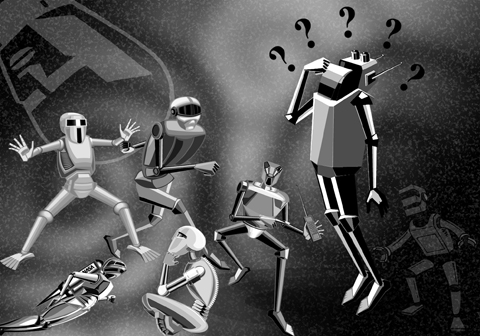You may think that the cuddly rubber-skinned dinosaur robot on Steve Bannerman’s shoulder is just another low-priced Christmas gift. But to Bannerman, a former Apple staffer who set up Quicktime TV (which became the iTunes Store), Pleo, as the dinosaur is called, might just be the future of human-machine interaction.
Pleo, made by a company called Ugobe, coos and even sings. Rub its neck and stomach and it blinks its baby-like eyes and turns toward you and writhes happily. It’s an instant emotional draw.
“Stroke him! He likes it,” Bannerman said.

ILLUSTRATION: TANIA
“He’s got sound and video sensors,” he said.
When it’s stroked, the machine reacts with — well, you’d call it pleasure.
Bannerman has only been with Ugobe since April; he’d previously cashed out of Apple at the height of the dotcom boom. But Pleo fascinated him.
“I fell in love with this dinosaur,” he said. “I loved the artificial intelligence component.”
He points to Wall-E, Pixar’s latest.
“You buy a US$99 [Wall-E] robot but they don’t work particularly hard to give it personality. And as much as I love my iPhone, there’s no chance it’s going to love me back,” he said.
That’s the difference about Pleo, he said: It will react to you.
But Ugobe is not alone in trying to build “emotional” machines. Last week the Science Museum in London unveiled an exhibition of “emotional” robots called Emotibots — which, according to Holly Cave of the museum, “is about robots that can trigger emotional responses in people, or even look like they have human-like emotions themselves.”
One that best demonstrates a sort of personality is iC Hexapod, developed by Matt Denton of MicroMagic Systems. It’s the latest in a line of six-legged walking robots created by Denton. It looks like a metallic insect whose eyes are programmed to search for people’s faces. When it finds a face, it follows it around. If the human moves towards iC, it recoils. If the human takes a step back, iC stretches out and leans forward attentively.
The emotional response this generates is remarkable.
If a child interacts with iC Hexapod, the robot seems to respond with similarly childish movements. If an adult examines iC, the robot studies them back. As a result it becomes easy to project some sort of character and personality on to the robot as it interacts so fluidly and precisely to every move.
The key to building emotion into robots is about letting people impose their own versions on them, said Bannerman, who explains why Ugobe didn’t follow Sony by making Pleo a robot dog (or cat).
“People have an expectation of what a dog or cat will behave like. It’s more difficult to suspend your disbelief when you’re looking at something that’s like, but isn’t, a dog or cat. It’s easier with a dinosaur,” he said.
iC Hexapod doesn’t look much like a dog or cat. It stands and moves around on its six legs. Denton also programmed the onboard processors which spring all the hardware into life: A “p.Brain” controls the movement of the legs, body, neck and face.
Denton describes himself as an animatronics designer and creative engineer, and his credits include the lip-syncing baby in Massive Attack’s Teardrop pop video (bit.ly/44aPZc) and creatures from Lost In Space and the children’s hit In The Night Garden.
iC Hexapod comes from a more recent interest in the arts field, which has also included a collaboration with Dante Leonelli, an artist who works with light, at Kinetica Museum’s launch exhibition in November 2006.
This was followed by last February’s Monster Mash, a more DIY affair which provided a platform for a test version of iC and other work from designers in the creature effects industry to let their imaginations run riot, outside of the confines of directors, scripts and storyboards.
It’s not only iC Hexapod’s movements and reactions that appear to mimic humans, it’s also its inbuilt sense of memory.
“Once I had the initial prototype up and running, and I had a hexapod that could ‘see’ and respond to the people it met, it became a short jump to allow it to ‘remember’ them, too,” Denton said. “Once iC has locked on to a person’s face, I’ve programmed it to wait a short time and then capture that face as a digital photo. The robot has an Internet connection so, as soon as it has met someone and remembered them — or rather taken their photo — it publishes the image to its blog.”
The photos on iC Hexapod’s blog (hexapodrobot.com), which will also be projected on large screens at the Science Museum, are simple JPegs, but show something quite unique: the expressions people pull when confronted with, and interacting with, a very personable robot. They also show what humans look like from a robot’s point of view.
How useful are emotions in computers, though?
“The hardest thing people work at is establishing relationships,” Bannerman said. “Pleo is about an emotional relationship and a bond. The endgame is the next-generation interface. It’s the difference between R2-D2 in Star Wars and Commander Data in Star Trek: The Next Generation. R2-D2 is limited in its interface. But if you get the interface right then we can explore the whole depth of the machine. It’s not that people don’t want to use all their machines’ capabilities — it’s that the barrier to use is too great. So our philosophy is really to breathe life into any machine.”
He thinks for a minute.
“Maybe the next one will be emotional and not entertainment.” But for now, the dinosaur will certainly do,” he said.

Taiwan has lost Trump. Or so a former State Department official and lobbyist would have us believe. Writing for online outlet Domino Theory in an article titled “How Taiwan lost Trump,” Christian Whiton provides a litany of reasons that the William Lai (賴清德) and Donald Trump administrations have supposedly fallen out — and it’s all Lai’s fault. Although many of Whiton’s claims are misleading or ill-informed, the article is helpfully, if unintentionally, revealing of a key aspect of the MAGA worldview. Whiton complains of the ruling Democratic Progressive Party’s “inability to understand and relate to the New Right in America.” Many
US lobbyist Christian Whiton has published an update to his article, “How Taiwan Lost Trump,” discussed on the editorial page on Sunday. His new article, titled “What Taiwan Should Do” refers to the three articles published in the Taipei Times, saying that none had offered a solution to the problems he identified. That is fair. The articles pushed back on points Whiton made that were felt partisan, misdirected or uninformed; in this response, he offers solutions of his own. While many are on point and he would find no disagreement here, the nuances of the political and historical complexities in
Taiwan is to hold a referendum on Saturday next week to decide whether the Ma-anshan Nuclear Power Plant, which was shut down in May after 40 years of service, should restart operations for as long as another 20 years. The referendum was proposed by the opposition Taiwan People’s Party (TPP) and passed in the legislature with support from the opposition Chinese Nationalist Party (KMT). Its question reads: “Do you agree that the Ma-anshan Nuclear Power Plant should continue operations upon approval by the competent authority and confirmation that there are no safety concerns?” Supporters of the proposal argue that nuclear power
The Centers for Disease Control and Prevention (CDC) earlier this month raised its travel alert for China’s Guangdong Province to Level 2 “Alert,” advising travelers to take enhanced precautions amid a chikungunya outbreak in the region. More than 8,000 cases have been reported in the province since June. Chikungunya is caused by the chikungunya virus and transmitted to humans through bites from infected mosquitoes, most commonly Aedes aegypti and Aedes albopictus. These species thrive in warm, humid climates and are also major vectors for dengue, Zika and yellow fever. The disease is characterized by high fever and severe, often incapacitating joint pain.